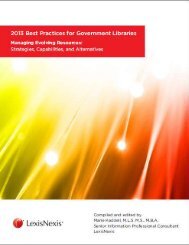2012 Best Practices for Government Libraries
2012 Best Practices for Government Libraries
2012 Best Practices for Government Libraries
You also want an ePaper? Increase the reach of your titles
YUMPU automatically turns print PDFs into web optimized ePapers that Google loves.
185<br />
BEST PRACTICES <strong>2012</strong><br />
our users, and that method needed to work with our current content vendors. The<br />
search was on.<br />
Both issues were worked simultaneously. As one piece of the puzzle fell into place,<br />
we took a look at the whole puzzle, to make sure we were still creating the right<br />
picture.<br />
We subscribe to both link resolver and discovery plat<strong>for</strong>m offered by Serials<br />
Solutions. They were moving into the access control field, so we decided to work<br />
with them to implement that service as well. After a few false starts, the access<br />
control product was terminated by the vendor. We were back to the drawing<br />
board.<br />
I attended presentations by two competing access control services: TDNet and<br />
OCLC’s EZ Proxy. We looked at the offerings, compared the services to our own<br />
needs, and chose EZ Proxy. We started the configuration process around the end<br />
of the year. We chose to have our service hosted, as we did not have the<br />
equipment, staff, or authorization to host our own instance. We submitted a<br />
configuration list consisting of our vendors and access links. In late winter, we<br />
received a test menu of our configuration, and we started tweaking. We were able<br />
to use our ILS vendor as an identity provider to EZ Proxy. Once a customer<br />
registered <strong>for</strong> an account, he/she had access to our licensed content in 24 hours.<br />
We were also able to restrict access by Patron Type. Patron Types were hard-coded<br />
into the config file and designated as “valid” or “not valid.” We could now offer our<br />
licensed content to all authorized library cardholders.<br />
Also in late fall, we acquired a trial of LibGuides from Springshare. As we started<br />
creating content, we realized that this plat<strong>for</strong>m offered exactly what we wanted in a<br />
Customer Intranet. We can have an unlimited number of content creators. The<br />
site admin assigns permissions to the content creators as needed, giving more staff<br />
the ability to add content. Creating content in the plat<strong>for</strong>m is very easy. Live and<br />
recorded training is available, but the GUI is very intuitive. Content is easily reused<br />
and shared, making updates much easier than coding separate pages in a site. We<br />
discovered that our A-Z list could be imported from our Data Management list in<br />
Serials Solutions. The import process took a few seconds at most, and our A-Z list<br />
was duplicated. These “master” links could then be re-used on other “pages.” As<br />
the links change, staff update the master list, and all other re-used links are<br />
updated at the same time. Our access control product works seamlessly, as using<br />
access control is as easy as checking a box. Customization of the header and<br />
footer is as easy as entering the code. If you have no code to enter, but want<br />
customization, the staff at Springshare will help you out. This plat<strong>for</strong>m lives in The<br />
Cloud, which means your content does not need to be altered locally and uploaded<br />
to another server; eliminating the need to understand yet another application. In<br />
the six months we have been with the plat<strong>for</strong>m, we have not lost access once. SEO<br />
is optimized, making our content discoverable in search engines (read “Google”).<br />
We have since learned that our LibGuides content is also discoverable via Summon,<br />
Serials Solutions’ discovery plat<strong>for</strong>m.



